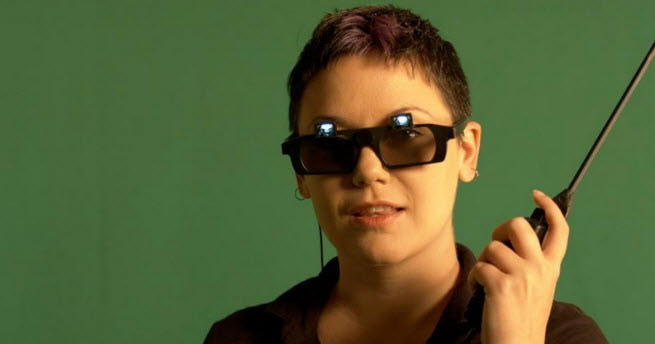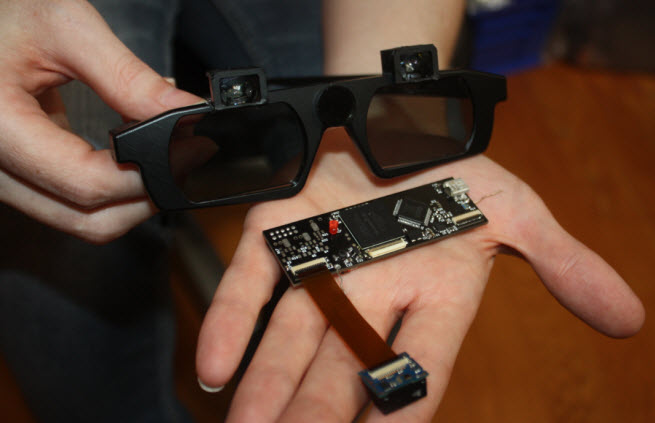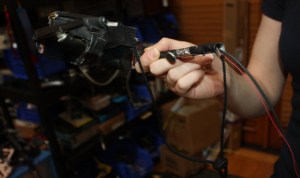GamesBeat: So your goal is 2014. Do you have a more detailed timetable?
Johnson: For Kickstarter, we have an earlier preview, which is about 100 pairs of glasses that we’re delivering in the April-May time frame. These are just to get the glasses out to people who are interested in the technology, to begin development early. The bulk of the Kickstarter will be delivered around September. Post-Kickstarter we have visions on how to grow the company and move into retail.
GamesBeat: Is that aimed at more developers than consumers?
Ellsworth: The Kickstarter? It’s kind of across the board. One of the things that resonated big with people was the whole RFID grid mixed with D&D. Board gamers were one aspect of it. We’ve had a lot of interest from educational institutions, using it as a learning device and using it more specifically for AR research. Movie studios and other companies have gone into it, and gamers in general.
A lot of them are just enthusiasts who are finally like, “Wow, AR is at an affordable price and works well. We can jump in and start exploring new worlds that we couldn’t before.”
GamesBeat: Oculus seemed to do a pretty good business just selling to developers for a while. That allows you to go to another stage and have revenue coming in. Does that seem like the path that you guys would follow?
Ellsworth: Units are still selling very briskly on our website. People are interested in getting in line to get units after the Kickstarter stuff comes out this spring.
GamesBeat: Do you have a certain number of hardware spins you think you’ll do before you get to a consumer-grade product?
Johnson: The September timeline is the first revision that’s consumer-grade. Internally we’ll have lots of steps. At GDC, we’ll have probably two different revisions from what you see now. We’ll keep on progressing the technology to make it smaller, better optic choices, progressions like that.
Ellsworth: We have a road map with certain check points we have to get to as far as miniaturizing electronics and getting our sample optics to increase the fidelity. By the end of the summer, that’s when we do the manufacture for our first X number of units that go out.
Johnson: People knew where we were going, but no one had seen the HD yet. All the demos were just SD.
Ellsworth: In the days prior to the Kickstarter, it was difficult getting the manufacturers of some of these components to work directly with us. Then we make this huge splash on Kickstarter, and now we have them banging on our door. “Please use our display! We’ll give you design services!” That’s great. It’s helping us a lot.
GamesBeat: Is something like a $99 product visible to you right now, as far as how quickly you could get there?
Johnson: The price points we chose were based on Kickstarter volume levels. If we had full retail, that will allow us to do volume purchases and things like that. One of the things we had early on in our design process is that there are different avenues we could take the glasses as far as components we could put out. You could imagine a kids’ product where we’re using a lower-resolution projector or different combinations of things that could lower the price point. There’s also the opposite direction, with higher-resolution panels and more precision components that we could do for higher-end use cases.
GamesBeat: Do you see augmented reality as a very different market from virtual reality? Is there room for the different players here?
Johnson: Everyone complements everyone else. It’s not like AR or VR is going to replace watching TV on the couch. What you’ll find is that, initially, you’ll see applications that barely take advantage of either space. As people get to the hardware and are able to experiment and try crazy new ideas, you’ll see unique things for AR and VR alike. It’ll be a growth market for both.
GamesBeat: How do you look at the software that you need to come up with? What do you have to do to get that content going?
Johnson: One of the first things I did over the summer was integrated this into Unity. It’s the most popular engine out there right now. It’s also one of the strongest engines for mobile devices. The goal for the Unity integration was to make it as quick and painless as possible. Angry Bots, the joystick demo, is a sample game that comes with Unity. It takes about three minutes to get up and running on our system. We’ve had game jams with other people that use Unity, so we can understand what they’re doing and further develop that plug-in.
There’s a low-level SDK, and if you have a custom app or a custom engine, you can talk to that. Integration is fairly easy in that regard. Likewise, now that we have Brian [Bruning] and Christina [Engel] on board, we’re starting to engage developers and get them exposed to the technology, understanding what they’re doing and how they can use it, building up the environment in that regard.
On the VR side, Valve announced the OpenVR Initiative. If you remember the early days of 3D technology, you had OpenGL, the OpenGL mini-driver, the Glide driver. You had all these different APIs from different vendors. This is an effort to make sure games aren’t written only for the Oculus or only for us. You write it for OpenVR. Now you have this giant library of games that work on multiple devices.
GamesBeat: What’s an example of an experience that’s written for this, versus taking something that’s ported for somewhere? What more could you do to impress people if you’re going beyond just a port?
Johnson: That’s part of what we’re doing right now for GDC. The others in the room there are working on some unique experiences that we’ll show off for GDC.
GamesBeat: And that maybe involves things like the wand or the RFID grid?
Johnson: It’ll involve different input devices and different control mechanisms and different orientations of the surface.
GamesBeat: Are you expanding very much as far as the size of the company?
Ellsworth: Yeah, we’re staffing up on the production side and the engineering side. That’s been one of our challenges since Kickstarter.
GamesBeat: If I were Valve, I’m not sure I would let you guys go. Have they asked for a stake in the company at all?
Ellsworth: No. Like I said, most of the people in the company hadn’t seen what we were doing. A handful of people came down and played it all the time, but maybe only five percent of the company had seen our prototypes. It was a big leap for them. They were a software company. This was that big head crab thing. I was doing a lot of hand-waving – like, “These can be miniaturized!” But that leap was difficult.
GamesBeat: You’re going to have to get a bigger house, then.
Johnson: We’re being frugal [laughter]. Once we get another infusion of cash, getting a proper office space and kicking everyone out of my house is the next big goal.
VentureBeat's mission is to be a digital town square for technical decision-makers to gain knowledge about transformative enterprise technology and transact. Learn More

















![Reblog this post [with Zemanta]](http://img.zemanta.com/reblog_e.png?x-id=514c164c-fe51-4b05-a2d9-f7d43c41e28e)
